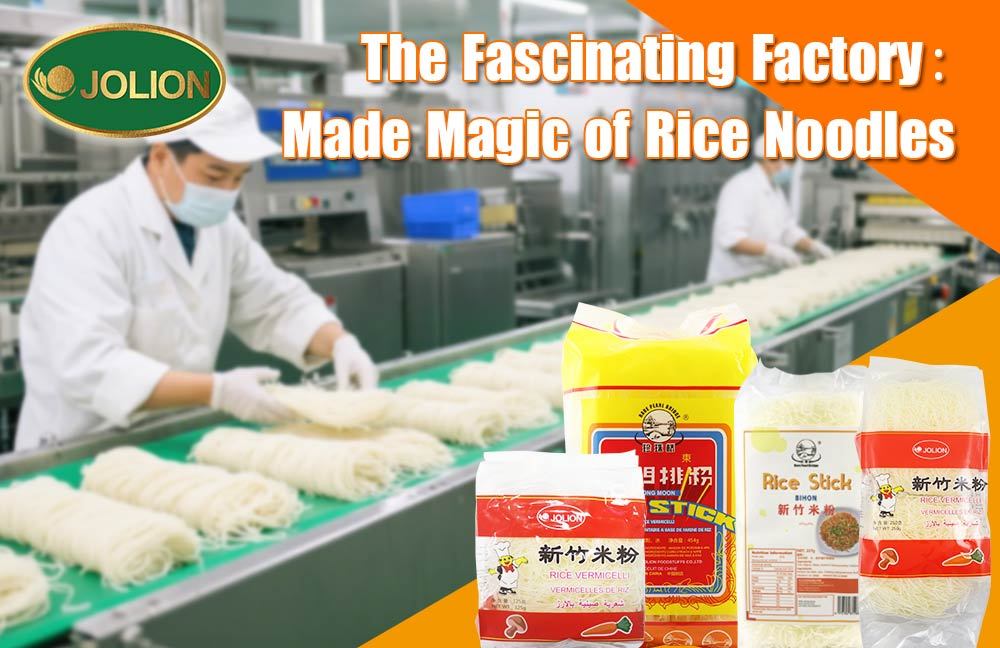
- Elevate Your Dishes with JOLION Foods’ 500G Chicken Base Powder2025-11-02JOLION Foods, a renowned chicken powder manufacturer, provides an exceptional solution with its 500G Chicken Base Powder Chicken Powder.
- Discover JOLION Foods: Your Premier Wholesale Sauce Supplier2025-11-01JOLION Foods Company, a wholesale sauce supplier, has emerged as a leader in this sector since its inception in the 2000s in Zhongshan City, China.
- How to Start a Sauce Business in 7 Steps2025-12-01
The Fascinating Factory:Made Magic of Rice Noodles
The Fascinating Factory:Made Magic of Rice Noodles
Have you ever slurped up a delicious bowl of rice noodles and wondered, “How on earth did these slender, scrumptious strands come to be?” Well, prepare to be whisked away on a mouth - watering journey through the factory - made world of rice noodles!

The Magical Transformation from Grain to Noodle
The Star Ingredient: Rice Selection
Our adventure begins with the star of the show - rice! Factories carefully choose high - quality long - grain or medium - grain rice. It's like picking the best athletes for a sports team; these rice varieties have just the right amount of starch to give our noodles that perfect texture. The rice has to be as pure as can be, free from any yucky impurities, mold, or other unwanted guests.
Soaking: The Rice's Soak - and - Soften Party
Once the rice is chosen, it's time for a relaxing soak in water. This soak can last anywhere from 2 to 48 hours. It's like the rice is taking a long bath, getting all soft and cozy. During this time, not only does the rice become easier to work with, but it also sheds some of its impurities and extra starches. It's like the rice is getting rid of its old skin to reveal a new, more noodle - friendly self.
Grinding: From Grains to Smooth Slurry
After the soak, the rice is drained and sent to the grinder. Think of it as a rice - to - slushy machine! Whether it's a traditional stone grinder or a high - tech industrial one, the goal is the same - to turn the rice into a super - smooth, consistent slurry. The finer the slurry, the more delicate and smooth our final noodles will be. It's like creating the smoothest canvas for a masterpiece.
Mixing and Feeding: A Little Something Extra (or Maybe Not)
Some factories might add a few little extras to the rice slurry at this stage. A splash of water, a pinch of salt, or other ingredients to boost flavor, texture, or shelf - life. But many top - notch manufacturers prefer to let the rice do the talking and keep additives to a minimum. Once mixed, the slurry is then carefully fed into the next part of the production line, like a carefully choreographed dance move.
Extrusion: The Noodle - Shaping Extravaganza
One of the most exciting parts is the extrusion process. The rice slurry is forced through a die with tiny holes. It's like squeezing toothpaste through a tube, but instead of toothpaste, we get long, thin noodle - like strands! By changing the size and shape of the die, factories can create different types of rice noodles, from the super - thin vermicelli that's perfect for spring rolls to thicker noodles for heartier soups.
Steaming and Cutting: A Different Path to Noodle Glory
Another way to shape the noodles is through steaming and cutting. The rice slurry is poured onto a flat surface, like a conveyor belt, and steamed until it forms a solid sheet. It's like making a giant rice - based pancake! Once cooled, this sheet is cut into various noodle shapes, like wide, flat noodles that are great for stir - fries.
Cooking: The Final Touch of Edibility
Shaped noodles are now ready to be cooked. They're sent through a big, industrial steamer, where the starch in the noodles gelatinizes. It's like the noodles are getting a magical cooking transformation, becoming soft and ready to eat. The cooking time is carefully watched, like a hawk watching its prey, to make sure the noodles are cooked just right - not too soft, not too hard.
Cooling and Drying: Noodles Take a Chill Pill (and Get Dried)
After cooking, the noodles need to cool down quickly. Fans or cool air chambers help with this, like a refreshing breeze on a hot day. Once cooled, they're dried to reduce their moisture content. This is important for making the noodles last longer. They can be air - dried in a special environment or put in drying ovens. It's like the noodles are getting ready for a long - term storage adventure.
Packaging: The Noodles Get Dressed for the Store
Finally, the dried rice noodles are weighed and packaged into different sizes. It's like dressing up the noodles for their big debut in stores. The packaging is designed to keep the noodles safe from moisture, oxygen, and any rough handling. Some packages even come with seasonings, making it super easy for us to whip up a delicious meal at home.
At Jolion, we take pride in our extensive experience in the food production industry. We are experts in crafting not only a wide variety of rice noodles but also an array of other noodle products. Whether you're interested in our unique rice noodle blends or want to explore our other noodle offerings, we're here to share our product knowledge with you. Don't hesitate to reach out and consult with us to discover more about the wonderful world of noodles we have to offer.
Related News
- 2025-11-02Elevate Your Dishes with JOLION Foods’ 500G Chicken Base Powder
- 2025-11-01Discover JOLION Foods: Your Premier Wholesale Sauce Supplier
- 2025-12-01How to Start a Sauce Business in 7 Steps
- 2025-12-01How Long Can Canned Foods Last?
- 2025-11-28Chili Powder: Crafting, Usage, and Custom Spices & Sauces Solutions for B2B Partners
- 2025-11-28Curry Powder: Crafting, Usage, and Customized Solutions for B2B Partners
Start Your Seasoning Sauce Business by a Free Quote
GET FREE QUOTES
If you are interested in our services, let's have a try on the first project
